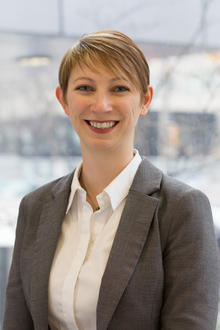Byline: Wynona Klemt
“You are biased. And so am I,” was the message that started off the Equity, Diversity & Inclusion (EDI) seminar last week. Bias in science and academia is now being recognized as a prevalent problem, influencing hiring practices, attrition rates, and collaborations.

The seminar drew a group of faculty, graduate students, and post-docs interested in learning more about EDI, what it is, and why it is important. Biology doctoral student Samantha Burke wanted to attend because she knows that subconscious discrimination is pervasive in academia.
“I have witnessed biases cropping up in many different places,” said Burke. “I was hoping for some tools to identify the biases of myself and others to help move toward a more fair and inclusive system.”
Canadian scientific funding bodies, including NSERC, CIHR, and SSHRC, are now requiring more explicit statements on Equity, Diversity and Inclusion (EDI) in their applications, as well as explanations on how scientists are incorporating aspects of sex and gender into their research when applicable. However, EDI is something that many faculty have little to no training in but are now expected to incorporate into their grant applications, as well as hiring practices and mentorship.
It is daunting but making an effort to educate yourself is the first step to incorporating EDI into your professional life. Acknowledgement of bias and inherent privilege was at the forefront of the seminar, and something Willis consistently referred to.
Using current studies that have examined the benefits of ethnic and gender diversity in science, gender disparities in STEM and academia as well as studies on discrimination and unconscious biases, Willis illustrated how crucial diversity is for good science and company/group performance and leads to more innovation and increased social perceptiveness.
“I was surprised at the lack of research available for identifying biases with racialized people in STEM, compared to the relative wealth of information for gender disparities,” commented biology professor Laura Hug. “It points to a greater need to understand what drives racial imbalances in STEM fields/departments/labs.”
Willis mentioned that some of the barriers to gender diversity include: underrepresentation of women at high levels of academia and in STEM fields in Canada and a 32 per cent drop out rate by junior female scientists, engineers and technology employees as a result of hostile work environments, isolation, and a scarcity of effective sponsors.
Some EDI practices suggested by Willis to make the workplace less biased and more accommodating for women and underrepresented minorities include: the need to hold ourselves and others accountable, challenging our own assumptions and changing our language and behaviour to be more inclusive as well as calling out unconscious biases to make others justify their decisions and to start the conversation.
“I […] find that while the research is often good at identifying iniquities and areas of bias, steps to address or avoid these biases are not usually stated or shown how to be implemented,” said Hug. “I have some tools I use routinely to check if my reference letters are gendered, or to quantify and clarify my implicit biases, but I'd love more resources to help me navigate EDI more effectively and more empathetically.”
Willis also outlined some options on how to prevent creating a hostile work environment, avoid isolation, and a lack of sponsorship. These include actions such as having an open dialogue about professionalism and EDI in your group, and ensuring underrepresented groups have their ideas heard and are included on teams.
“I actually tried that today and I think it worked well,” Prof. Dale Martin explained. “I plan to explore more of the resources that came up during Dr. Willis' seminar and try to implement them.”
Burke left the seminar also keen to apply what she learned in her academic life. “[I] will be pursuing further EDI training to help identify my biases,” said Sam. “In the meantime, I am going be mindful to not use gendered language in professional writing.”
While the incorporation of EDI into TriAgency statements was brought up as a new norm, active steps and guidelines for these statements was not part of this seminar, something many faculty members expressed a need and desire to have more active training on the subject.
For the faculty and graduate students who attended this seminar, change starts in their own departments, research groups, and labs.
For Hug the seminar brought about a new perspective on the importance of representation such that isolation and professional etiquette norms can be better navigated. Martin found the seminar informative and made him even more vigilant about asking himself about his own biases.
Interested in learning more about systemic biases in science and academia? Here are some references to a few of the studies mentioned in Willis’ talk:
- Freeman, Richard B., and Wei Huang. "Collaboration: Strength in diversity." Nature News 513.7518 (2014): 305.
- Henry, Frances, et al. The equity myth: Racialization and indigeneity at Canadian universities. UBC Press, 2017.
- Hewlett, Sylvia Ann, et al. "The Athena factor: Reversing the brain drain in science, engineering, and technology." Harvard Business Review Research Report 10094 (2008): 1-100.
- Moss-Racusin, Corinne A., et al. "Science faculty’s subtle gender biases favor male students." Proceedings of the National Academy of Sciences 109.41 (2012): 16474-16479.
- Smith, Jessi L., et al. "Now hiring! Empirically testing a three-step intervention to increase faculty gender diversity in STEM." BioScience 65.11 (2015): 1084-1087.
- Woolley, Anita Williams, et al. "Evidence for a collective intelligence factor in the performance of human groups." Science 330.6004 (2010): 686-688.
- “Women in Science and Engineering in Canada.” National Science and Engineering Research Council, October 2017, https://www.nserc-crsng.gc.ca/_doc/Reports-Rapports/WISE2017_e.pdf